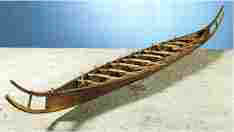The history of the Hjortspring Boat
Click the picture to get a larger one, full screen (45 kB)A model of the Hjortspring Boat (45kB),
build by G. Rosenberg 1937
Picture, courtesy of (1), fig. 9, p. 17.
The History:
A Boat like this was build by the early iron-age people (ca. 350 B.C.), probably somewhere at the eastern part of the Baltic Sea, at this time nobody knows where, it may be at the northern shores of current Germany, Zealand, southern part of Sweden or even the Baltic countries, but we don't believe it was nearby the finding site.
The first time someone found remaining of boat-like wood and iron weapons (spear odd) was in the 1880's in a small bog (ca. 45 x 50 m) on the island of Als (86 kB) in Denmark, when peat was dug.
During the First World War, the leader of local museum in Soenderborg, Jens Raben, was told about the find.
In 1920, after the war was ended and Soenderjylland was reunited with Denmark (it has been a part of Germany from 1864 until 1920), Jens Raben wrote to the National Museum about it.In 1921 excavation of the bog was begun, led by Gustav Rosenberg, a very experienced and painstaking conservator and archaeologist, this very difficult excavation was ended in 1922. Every piece was exactly drawn and the whole progress was photographed (the background-image (70 kB) of this web, is one of those pictures) and thereafter sent to Copenhagen for conservation, part of that history may be found at: The Department of Conservation at the National Museum.
After conservation a ship-drawing were made by the Norwegian engineer Fr. Johannessen based on the finds and published in:
"HJORTSPRINGFUNDET af G. ROSENBERG, Nordiske Fortidsminder, III bind, 1. hefte, 1937, Koebenhavn"
This book, with drawings, are the reference for the work of the guild.
The Boat:
Is the Hjortspring Find's most impressive single prize and Scandinavia's oldest preserved plank-built vessel, is a canoe more than 19 m long and consist of a bottom plank, a side- and a gunwale-plank on each side, whose ends are held together by two stem-blocks. All this gives a keel-less, round-bottomed vessel: at each end, the Boat is given two upward bent extensions, beaks or horns (see image at top of page). The Boat is mostly made of lime-wood, the bottom-plank and stems are locked together by oak-planks, as is the "horns". An arrangement of 10 ribs, made of a lime-wood seat and ash-pillars held together by bent hazel-branch, these rib's are sewed to cleats on the side-planks by rope made of lime-tree bast, as is all the fixing of the Boat, not a single piece of metal have been used!
The Boat's inner dimensions are about 13 m long and 2 m wide, the craftsmanship have been so splendid, that the weight of the vessel has been around 500 kg, with 24 men and equipment onboard, the total weight has been around 2500 kg.
The remaining finds:
The Hjortspring Find is much more than the Boat itself, from it we get a broad impression of weapons and armament from the pre-Roman Iron Age.
The following were found in more or less complete size and shape:
- More than 50 shields, made of lime-wood, it's the largest collection preserved shields from whole Europe's pre-history, all of the same basic shape, with lengths from 61 to 68 cm and width between 29 and 52 cm. There are remains indicating that there have been between 60 to 80 shields.
- Not less than 169 spears, of which 138 of iron (of quite different shapes, from 10 to 43.5 cm long) and 31 of bone or antler, the longest spear-shaft was 1.97 m long.
- 11 swords of quite different shape, but single edged and the tang lies in the middle axis of the sword's.
- There were, during the excavation, found rust-prints of small, thin rings of iron. There can be no doubt but that these were the remaining traces of chain-mail, covering an area of 20 - 24 m2: 10 - 20 sets, the oldest known in Europe, probably imported from the Celts - those people who lived in Central Europe at that time.
- The first examples of turned wood in the Northern Europe, small canisters, 10 cm in diameter, and quite many other domestic utensils.
A more complete story are told in Weapons.
The last excavation:
In 1987 the bog was opened again, by Flemming Rieck, and 3 out of 20 small wooden objects from the Hjortspring Find were C14-dated to 350-300 B.C. with an uncertainty of 100 years.
Some part of the above story are referred from:
Da vaabene tav, Hjortspringfundet og dets baggrund, Flemming Kaul, Nationalmuseet, 1988
In 1989 the exhibition of the boat (24 kB) was reestablished at the National Museum in Copenhagen.



